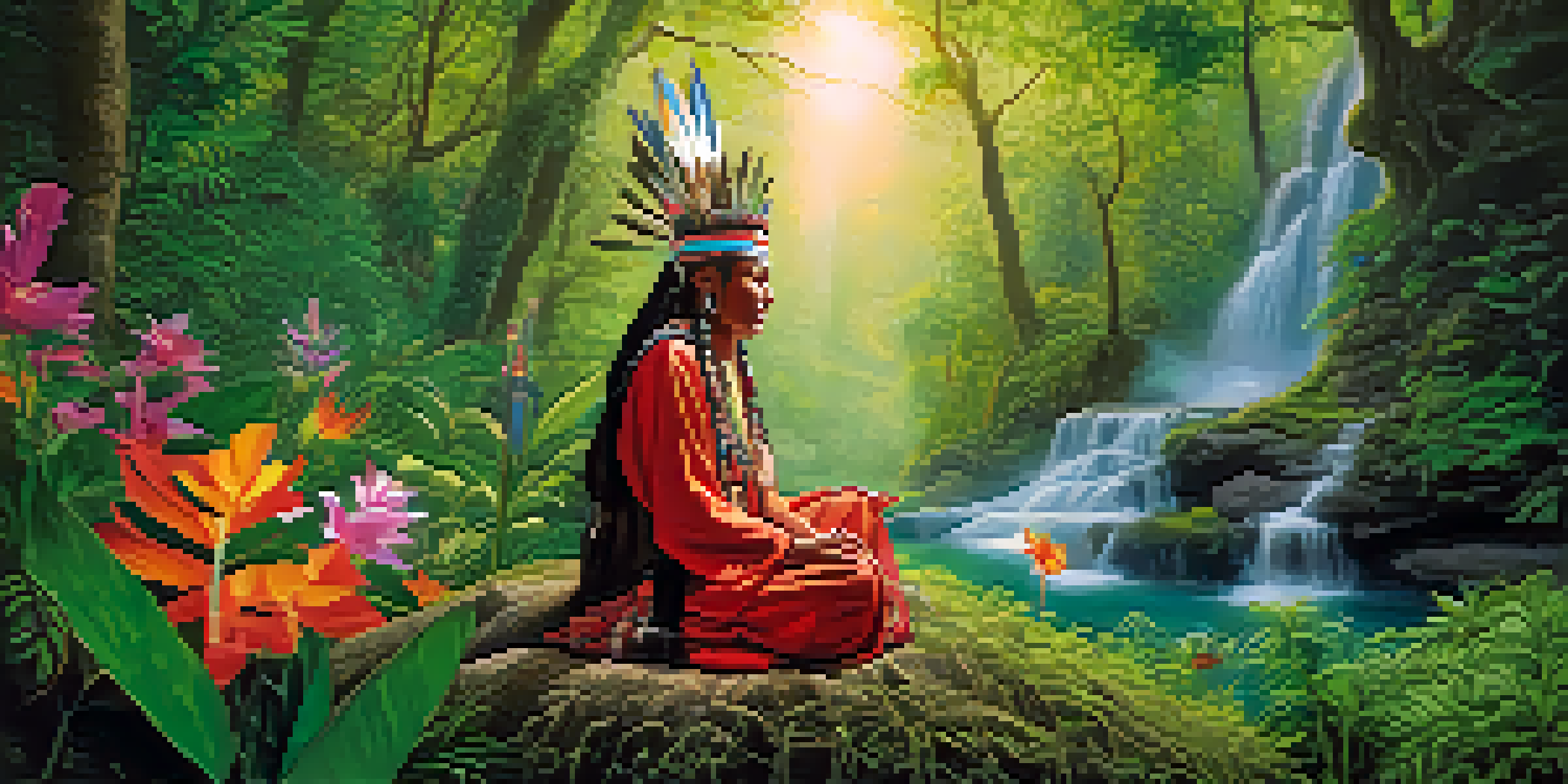Shamanic Practices: Entheogens in Indigenous Cultures

Understanding Shamanism and Its Cultural Significance
Shamanism is a spiritual practice that dates back thousands of years, rooted in various cultures around the globe. It involves a shaman, or spiritual healer, who mediates between the physical and spiritual worlds for the community's benefit. Often, these practices include rituals aimed at healing, divination, and guidance, making shamanism an integral part of many indigenous cultures.
Shamanism is not a thing of the past; it is a living tradition that continues to adapt and thrive in the modern world.
In essence, shamanism is not just a spiritual path; it's a way of life that emphasizes connection to nature and the community. Shamans often draw upon their environment, using local plants and animals as symbols and tools in their practices. This deep-rooted connection underscores the importance of preserving these traditions for future generations.
As we explore shamanism, it's crucial to recognize its diversity across different cultures—from the Siberian shamans to the Native American medicine men. Each tradition brings its unique perspective, yet they all share the common thread of seeking harmony between humans and the spiritual realm.
The Role of Entheogens in Shamanic Practices
Entheogens are substances that induce altered states of consciousness, often used in spiritual contexts. Common examples include peyote in Native American traditions and ayahuasca in Amazonian cultures. These substances are not taken lightly; they are viewed as sacred tools that facilitate communication with the spiritual world.

When consumed, entheogens can lead to profound insights, emotional healing, and a sense of interconnectedness with the universe. For many shamans, these experiences are essential for guiding their communities through challenges or spiritual crises. They serve as a bridge to access deeper knowledge and healing processes that are otherwise difficult to reach.
Shamanism Connects Spirit and Nature
Shamanism is a holistic spiritual practice that emphasizes the interconnectedness of humans, nature, and the spiritual realm.
It's important to note that the use of entheogens is often accompanied by rituals and guidance from experienced shamans. This ensures that the experiences are meaningful and integrated into one's life, rather than simply recreational. In this way, entheogens are respected as powerful allies in the spiritual journey.
Cultural Perspectives on Healing and Transformation
In many indigenous cultures, healing is seen as a holistic process that encompasses the mind, body, and spirit. Shamans often address not just physical ailments but also emotional and spiritual wounds, using entheogens as part of this comprehensive approach. This perspective contrasts sharply with many Western medical practices, which may focus solely on the physical symptoms.
The plants are our teachers, and they show us the way to heal ourselves and the world.
For instance, a shaman might use ayahuasca to help an individual confront deep-seated traumas, leading to emotional release and personal transformation. This healing process can foster a renewed sense of purpose and connection to one’s community and environment. The communal aspect of these practices also reinforces social bonds, making healing a collective effort.
By embracing a more integrated view of health, these cultures offer valuable lessons to the modern world. The focus on community, connection, and spiritual well-being can inspire new approaches to health and healing that prioritize the individual’s holistic experience.
Entheogens and Spiritual Journeys: Personal Narratives
Many individuals who have partaken in shamanic rituals involving entheogens share transformative stories that highlight their spiritual journeys. These narratives often reveal deep insights about life, purpose, and the interconnectedness of all beings. For example, someone might describe a vivid experience during an ayahuasca ceremony that led to profound emotional healing and a greater understanding of their life's path.
These personal accounts emphasize that the experience is not just about the substance itself, but also the setting, intention, and guidance involved in the journey. Participants often report feelings of unity with nature, enhanced creativity, and shifts in consciousness that lead to lasting changes in their lives. Such anecdotes serve to underline the powerful role entheogens can play when used within a supportive framework.
Entheogens as Sacred Healing Tools
Entheogens play a crucial role in shamanic practices, serving as sacred tools for facilitating deep spiritual insights and emotional healing.
While these experiences are deeply personal, they also reflect universal themes of growth, healing, and connection. As more people share these stories, a greater appreciation for the significance of entheogens in shamanic practices emerges, encouraging respectful exploration of these traditions.
Contemporary Interest in Shamanic Practices
In recent years, there has been a growing interest in shamanic practices, particularly among those seeking alternative healing methods. This resurgence can be attributed to a broader cultural shift towards holistic wellness and spiritual exploration. As people search for deeper meaning in their lives, many are turning to indigenous traditions that emphasize connection to nature and community.
This interest, however, raises important questions about cultural appropriation and respect for indigenous practices. It's vital to approach these traditions with sensitivity and understanding, recognizing their deep cultural roots and the wisdom they offer. Engaging with indigenous communities and learning from their teachings can foster a more respectful exchange.
Moreover, as scientific research begins to explore the therapeutic potential of entheogens, the conversation around these practices is evolving. The integration of traditional wisdom with modern science presents an exciting opportunity for healing and personal growth, but it must be done ethically and respectfully.
Legal and Ethical Considerations Surrounding Entheogens
The legal status of entheogens varies widely across different countries, often leading to confusion and misinformation. In some places, substances like psilocybin or ayahuasca are illegal, while in others, they may be decriminalized or regulated for medical use. This landscape makes it essential for individuals interested in these practices to stay informed about the legal implications.
Ethically, the growing popularity of entheogens raises concerns about exploitation and commodification of indigenous practices. It is crucial to engage with these traditions respectfully and to support indigenous communities in preserving their cultural heritage. This means listening to their voices and ensuring they benefit from any interest in their practices.
Respecting Indigenous Practices
As interest in shamanic practices grows, it is essential to approach them with respect and sensitivity towards their cultural origins.
Navigating these legal and ethical considerations requires a commitment to understanding and respecting the complexities of indigenous cultures. By fostering dialogue and collaboration, we can help ensure that shamanic practices are honored and preserved for future generations.
The Future of Shamanic Practices and Entheogens
Looking ahead, the future of shamanic practices and entheogens is both promising and challenging. As more people seek out these experiences for healing and personal growth, it’s vital to cultivate a respectful understanding of their origins and meanings. This involves not only appreciating the wisdom of indigenous cultures but also ensuring that their practices are not diluted or misrepresented.
Additionally, ongoing research into the therapeutic benefits of entheogens could lead to new insights that bridge traditional healing methods with modern medicine. Such collaborations could enhance understanding of mental health issues and promote a more holistic approach to treatment. However, it’s essential that these conversations include indigenous voices and perspectives.

Ultimately, the future of shamanic practices will depend on our ability to honor and respect the traditions from which they stem. By fostering genuine connections and ethical practices, we can ensure that these powerful tools for healing and transformation remain alive and accessible for generations to come.